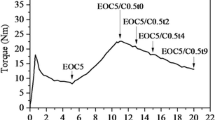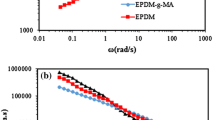Abstract
Pickering-like ethylene vinyl acetate copolymer (EVA)/organoclay nanocomposites were prepared by melt mixing with two different compatibilizers: polyethylene-grafted maleic anhydride and ethylene propylene diene monomer-grafted maleic anhydride. The linear dynamic viscoelasticity, transient and intermittent shear flows, thermal stability, and dispersion state of organoclays were investigated in detail. Before taking rheological measurements, transmission electron microscopy (TEM) and X-ray diffraction were employed to evaluate organoclay intercalation and exfoliation in the nanocomposites. Interestingly, TEM micrographs showed that organoclay platelets were trapped at the interface and bent around the compatibilizer droplets, such as in Pickering emulsions. The intermittent shear flow experiments indicate that structural reorganization during the rest period upon cessation of the initial transient occurred in the EVA/Cloisite 20A nanocomposites, while there was very little evidence of such a state for the EVA/Cloisite 30B nanocomposites. Addition of the compatibilizers to the nanocomposites leads to an increase in overshoot peak both in the initial transient flow and during intermittent shear flow after a rest time. Thermogravimetric analysis and real time Fourier transform infrared spectroscopy indicated that organoclays retard thermal degradation depending on organoclay concentration. The results of micro-scale cone calorimetry showed that the peak of the heat release rate and total heat release of the EVA/organoclay nanocomposites decreased dramatically compared with those of pure EVA, and both compatibilizers could considerably improve the thermal stability and remarkably delayed thermal oxidative degradation of nanocomposites.











Similar content being viewed by others
References
Ramanathan T et al. (2008) Functionalized graphene sheets for polymer nanocomposites. Nat Nanotechnol 3(6):327–331
Balazs AC, Emrick T, Russell TP (2006) Nanoparticle polymer composites: where two small worlds meet. Science 314(5802):1107–1110
Gelfer MY et al. (2005) Relationships between structure and rheology in model nanocomposites of ethylene-vinyl-based copolymers and organoclays. Macromolecules 38(9):3765–3775
Starr FW, Schrøder TB, Glotzer SC (2002) Molecular dynamics simulation of a polymer melt with a nanoscopic particle. Macromolecules 35(11):4481–4492
Pack S et al. (2009) Mode-of-action of self-extinguishing polymer blends containing organoclays. Polym Degrad Stab 94(3):306–326
Pack S et al. (2009) Segregation of carbon nanotubes/organoclays rendering polymer blends self-extinguishing. Macromolecules 42(17):6698–6709
Khatua B et al. (2004) Effect of organoclay platelets on morphology of nylon-6 and poly (ethylene-r an-propylene) rubber blends. Macromolecules 37(7):2454–2459
Yoo Y et al. (2005) Influence of addition of organoclays on morphologies in nylon 6/LLDPE blends. Macromol Chem Phys 206(8):878–884
Sinha Ray S et al. (2004) Role of organically modified layered silicate as an active interfacial modifier in immiscible polystyrene/polypropylene blends. Polymer 45(25):8403–8413
Gavgani JN, Adelnia H, Gudarzi MM (2014) Intumescent flame retardant polyurethane/reduced graphene oxide composites with improved mechanical, thermal, and barrier properties. J Mater Sci 49(1):243–254
Moussaif N et al. (2012) Synergistic reinforcement of nanoclay and mesoporous silicate fillers in polycaprolactone: the effect of nanoclay on the compatibility of the components. Polymer 53(17):3741–3748
Kalluru SH, Cochran EW (2013) Synthesis of polyolefin/layered silicate nanocomposites via surface-initiated ring-opening metathesis polymerization. Macromolecules 46(23):9324–9332
Liu A et al. (2011) Clay nanopaper with tough cellulose nanofiber matrix for fire retardancy and gas barrier functions. Biomacromolecules 12(3):633–641
Bendahou A et al. (2011) Synergism effect of montmorillonite and cellulose whiskers on the mechanical and barrier properties of natural rubber composites. Macromol Mater Eng 296(8):760–769
Bangarusampath D et al. (2009) Rheology and properties of melt-processed poly (ether ether ketone)/multi-wall carbon nanotube composites. Polymer 50(24):5803–5811
Song PA et al. (2008) Flame-retardant-wrapped carbon nanotubes for simultaneously improving the flame retardancy and mechanical properties of polypropylene. J Mater Chem 18(42):5083–5091
Song P et al. (2011) Fabrication of exfoliated graphene-based polypropylene nanocomposites with enhanced mechanical and thermal properties. Polymer 52(18):4001–4010
Potts JR et al. (2011) Graphene-based polymer nanocomposites. Polymer 52(1):5–25
Jolfaei AF, et al. Effect of organoclay and compatibilizers on microstructure, rheological and mechanical properties of dynamically vulcanized EPDM/PP elastomers. Polym Bull 1–18
Wang Z et al. (2009) Mechanism on flame retardancy of polystyrene/clay composites-the effect of surfactants and aggregate state of organoclay. Polymer 50(24):5794–5802
Ma HY et al. (2008) Functionalizing carbon nanotubes by grafting on intumescent flame retardant: nanocomposite synthesis, morphology, rheology, and flammability. Adv Funct Mater 18(3):414–421
Guo Y et al. (2011) In situ polymerization of graphene, graphite oxide, and functionalized graphite oxide into epoxy resin and comparison study of on-the-flame behavior. Ind Eng Chem Res 50(13):7772–7783
Potts JR et al. (2011) Microwave-exfoliated graphite oxide/polycarbonate composites. Macromolecules 44(16):6488–6495
Solar L et al. (2008) Viscoelastic behavior of epoxy prepolymer/organophilic montmorillonite dispersions. J Polym Sci B Polym Phys 46(17):1837–1844
Ishida H, Campbell S, Blackwell J (2000) General approach to nanocomposite preparation. Chem Mater 12(5):1260–1267
He Y et al. (2013) Factors that Affect Pickering Emulsions Stabilized by Graphene Oxide. ACS Appl Mater Interfaces 5(11):4843–4855
Bon SA, Colver PJ (2007) Pickering miniemulsion polymerization using laponite clay as a stabilizer. Langmuir 23(16):8316–8322
Yang HJ, Cho WG, Park SN (2009) Stability of oil-in-water nano-emulsions prepared using the phase inversion composition method. J Ind Eng Chem 15(3):331–335
Aveyard R, Binks BP, Clint JH (2003) Emulsions stabilised solely by colloidal particles. Adv Colloid Interf Sci 100:503–546
Binks BP (2002) Particles as surfactants—similarities and differences. Curr Opin Colloid Interface Sci 7(1):21–41
Binks BP et al. (2005) Temperature-induced inversion of nanoparticle-stabilized emulsions. Angew Chem 117(30):4873–4876
Binks BP, Rodrigues JA (2005) Inversion of emulsions stabilized solely by ionizable nanoparticles. Angew Chem 117(3):445–448
Fenouillot F, Cassagnau P, Majeste J-C (2009) Uneven distribution of nanoparticles in immiscible fluids: morphology development in polymer blends. Polymer 50(6):1333–1350
Vermant J et al. (2004) Coalescence suppression in model immiscible polymer blends by nano-sized colloidal particles. Rheol Acta 43(5):529–538
Huitric J et al. (2009) Rheological, morphological and structural properties of PE/PA/nanoclay ternary blends: effect of clay weight fraction. J Rheol 53(5):1101–1119 (1978-present)
Dong W et al. (2005) Preparation of high barrier and exfoliated-type nylon-6/ultrafine full-vulcanized powdered rubber/clay nanocomposites. Macromolecules 38(11):4551–4553
Dehsari HS et al. (2014) Efficient preparation of ultralarge graphene oxide using a PEDOT: PSS/GO composite layer as hole transport layer in polymer-based optoelectronic devices. RSC Adv 4(98):55067–55076
Adelnia H et al. (2013) Synthesis of monodisperse anionic submicron polystyrene particles by stabilizer-free dispersion polymerization in alcoholic media. Colloid Polym Sci 291(7):1741–1748
Gavgani JN, Shahrousvand M, Aslzadeh MM (2013) Monitoring the effects of homogeneity methanol/water/monomer on the mode of polymerization of styrene: dispersion polymerization versus emulsion polymerization. Colloid Polym Sci 291(10):2299–2309
Saltikov SA (1967) The determination of the size distribution of particles in an opaque material from a measurement of the size distribution of their sections, in Stereology. Springer. p. 163–173
Polymer Interface and Adhesion. 1982: Taylor & Francis
Wilson R et al. (2011) Influence of clay content and amount of organic modifiers on morphology and pervaporation performance of EVA/clay nanocomposites. Ind Eng Chem Res 50(7):3986–3993
Lee KM, Han CD (2003) Rheology of organoclay nanocomposites: effects of polymer matrix/organoclay compatibility and the gallery distance of organoclay. Macromolecules 36(19):7165–7178
Song PA et al. (2012) Permeability, viscoelasticity, and flammability performances and their relationship to polymer nanocomposites. Ind Eng Chem Res 51(21):7255–7263
Gavgani JN, et al. (2014) Intumescent flame retardant polyurethane/starch composites: thermal, mechanical, and rheological properties. J Appl Polym Sci 131(23)
Wagener R, Reisinger TJ (2003) A rheological method to compare the degree of exfoliation of nanocomposites. Polymer 44(24):7513–7518
Winter HH (1997) Analysis of dynamic mechanical data: inversion into a relaxation time spectrum and consistency check. J Non-Newtonian Fluid Mech 68(2):225–239
Song P et al. (2009) Effects of reactive compatibilization on the morphological, thermal, mechanical, and rheological properties of intumescent flame-retardant polypropylene. ACS Appl Mater Interfaces 1(2):452–459
Cui Y, van Duijneveldt JS (2012) Microcapsules composed of cross-linked organoclay. Langmuir 28(3):1753–1757
Sumita M et al. (1991) Dispersion of fillers and the electrical conductivity of polymer blends filled with carbon black. Polym Bull 25(2):265–271
Çopuroğlu M, Şen M (2004) A comparative study of thermal ageing characteristics of poly (ethylene‐co‐vinyl acetate) and poly (ethylene‐co‐vinyl acetate)/carbon black mixture. Polym Adv Technol 15(7):393–399
Jin J, Chen S, Zhang J (2010) UV aging behaviour of ethylene-vinyl acetate copolymers (EVA) with different vinyl acetate contents. Polym Degrad Stab 95(5):725–732
Chattopadhyay D et al. (2006) Thermal and viscoelastic properties of polyurethane-imide/clay hybrid coatings. Polym Degrad Stab 91(8):1837–1849
Sreedhar B, Chattopadhyay D, Swapna V (2006) Thermal and surface characterization of polyurethane–urea clay nanocomposite coatings. J Appl Polym Sci 100(3):2393–2401
Xiong J et al. (2007) Reinforcement of polyurethane composites with an organically modified montmorillonite. Compos A: Appl Sci Manuf 38(1):132–137
Pack S et al. (2010) Role of surface interactions in the synergizing polymer/clay flame retardant properties. Macromolecules 43(12):5338–5351
Zanetti M et al. (2002) Cone calorimeter combustion and gasification studies of polymer layered silicate nanocomposites. Chem Mater 14(2):881–887
Zhao C et al. (2004) Preparation and characterization of polyethylene–clay nanocomposites by using chlorosilane‐modified clay. J Appl Polym Sci 93(2):676–680
Adams J (1987) Synthetic organic chemistry using pillared, cation-exchanged and acid-treated montmorillonite catalysts—a review. Appl Clay Sci 2(4):309–342
Guduri B, Luyt A (2007) Comparison of the influence of different compatibilizers on the structure and properties of ethylene vinyl acetate copolymer/modified clay nanocomposites. J Appl Polym Sci 105(6):3612–3617
Author information
Authors and Affiliations
Corresponding author
Additional information
Jaber Nasrollah Gavgani and Amir Faramarzi Jolfaei contributed equally to this work.
Electronic supplementary material
Below is the link to the electronic supplementary material.
ESM 1
(DOC 799 kb)
Rights and permissions
About this article
Cite this article
Gavgani, J.N., Jolfaei, A.F., Hakkak, F. et al. Rheological, morphological and thermal properties of pickering-like EVA/organoclay nanocomposites. J Polym Res 22, 99 (2015). https://doi.org/10.1007/s10965-015-0742-2
Received:
Accepted:
Published:
DOI: https://doi.org/10.1007/s10965-015-0742-2




